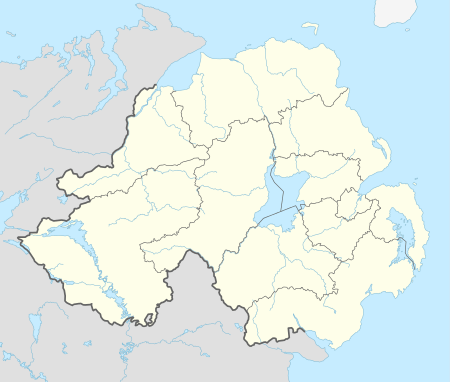Enniskillen Castle
Enniskillen Castle is situated in Enniskillen, County Fermanagh, Northern Ireland. It was originally built in the 16th century and now houses the Fermanagh County Museum and the regimental museum of the Royal Inniskilling Fusiliers and the 5th Royal Inniskilling Dragoon Guards.
| Enniskillen Castle | |
|---|---|
| Enniskillen, Co. Fermanagh | |
Enniskillen Castle 2011 | |
 Enniskillen Castle | |
| Coordinates | 54°20′46″N 07°38′42″W |
| Type | Castle |
| Site information | |
| Open to the public | Yes |
| Website | www |
| Site history | |
| Built | 1428 |
History
The first Enniskillen castle was built on this site by Hugh Maguire in 1428.[1] It featured greatly in Irish rebellions against English rule in the 16th century. It was besieged by Captain John Dowdall's troops at the start of 1594 and fell on 2 February after a short siege, when the occupants were massacred after they surrendered.[2] The castle was again under siege later that year but was relieved. The fortress finally fell to the irish in 1595. The castle remained in Irish hands until it fell to the crown's Irish ally, Niall Garve O'Donnell in the summer of 1602. Captain William Cole remodelled and refurbished the castle adding the riverside tower at the south, known as the Watergate, in 1609.[1] The castle was remodelled as "Castle Barracks" as part of the response to a threat of a French invasion in 1796.[1] Castle Barracks became the home of the 27th Regiment of Foot in 1853.[3] The regiment moved to purpose-built facilities at St Lucia Barracks, Omagh in 1875[4] and evolved, after amalgamation, to become the Royal Inniskilling Fusiliers in 1881.[5]
The barracks continued to be used by other regiments and, from November 1939, they became to home of the North Irish Horse, a Territorial Army unit.[6] The barracks were decommissioned in 1950[7] and were converted for use as council depot.[1] The castle was subsequently opened to the public as a heritage centre.[1]
Features and collections
The Castle provided the main defence for the west end of the town and guarded the Sligo road. It consists of two sections, a central tower keep and a curtain wall which was strengthened with small turrets called Bartizans. The design of the castle has strong Scottish influences. This can be particularly seen in the Watergate, which features two corbelled circular tourelles which were built about 1609.[8] It is a State Care Historic Monument.[9]
The castle is now home to the Fermanagh County Museum, which focuses on the county's history, culture and natural history.[1] Exhibits include the area's prehistory, natural history, traditional rural life, local crafts and Belleek Pottery, and history of the castle. It also contains information on the Maguire family. The castle also houses the Inniskillings Museum, which is the regimental museum of the Royal Inniskilling Fusiliers and the 5th Royal Inniskilling Dragoon Guards.[10]
- The courtyard of the Castle
 Reconstruction of the Castle
Reconstruction of the Castle- The barracks was built inside the walls
References
- "Enniskillen Castle to receive £2.37 million in heritage funding". Medieval Histories. 6 November 2014. Retrieved 12 June 2018.
- James O'Neill, 'Threes sieges and two massacres: Enniskillen at the outbreak of the Nine Years War, 1593-5, The Irish Sword, xxx, no. 121 (2016), pp 241-9
- "No. 6279". The Edinburgh Gazette. 6 May 1853. p. 367.
- "Training Depots". Regiments.org. Archived from the original on 10 February 2006. Retrieved 16 October 2016.CS1 maint: BOT: original-url status unknown (link)
- "No. 24992". The London Gazette. 1 July 1881. pp. 3300–3301.
- Doherty p. 45
- "Enniskillen Castle". Majestic Castles in Ireland. Retrieved 12 June 2018.
- O'Neill, B (ed). (2002). Irish Castles and Historic Houses. London: Caxton Editions. p. 17.
- "Enniskillen Castle" (PDF). Environment and Heritage Service NI - State Care Historic Monuments. Archived from the original (PDF) on 29 February 2008. Retrieved 3 December 2007.
- "Welcome". The Inniskillings Museum. Retrieved 12 June 2018.
Sources
- Doherty, Richard (2002). The North Irish Horse, A Hundred Years of Service. Spellmount. ISBN 978-1862271906.
- James O'Neill, 'Threes sieges and two massacres: Enniskillen at the outbreak of the Nine Years War, 1593-5, The Irish Sword, xxx, no. 121 (2016), pp 241-9
External links
- Fermanagh County Museum - official site
- The Inniskillings Museum - official site
- "Three sieges and two massacres: Enniskillen at the outbreak of the Nine Years War 1593-5". academia.edu. 25 September 2016.